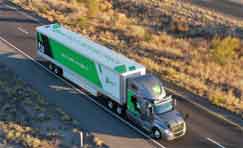Action continues hot and heavy in terms of self-driving or autonomous trucks, with tests now having been conducted in at least 28 state. But that testing has been dominated by just a few areas, those being (1) the “Texas Triangle” of Dallas, Houston and San Antonio; (2) along Interstate 10 going from Los Angeles to Jacksonville, FL; and (3) in Arizona.
Supply Chain Digest Says...
|
 |
| Michael Lasko, head of Safety and Quality for Boyle Transportation, an early adopter of ADAS technologies, said “These technologies work. They work extremely well. |
 |
What do you say? |
| Click here to send us your comments |
 |
| Click here to see reader feedback |
|
That includes some tests in which there was no back-up driver in the cab. For example, in late 2021, autonomous developer TuSimple made seven 80-mile trips on an interstate between Tucson and Phoenix during overnight hours with no driver. However, state patrol officers wer traveling nearby.
So it seems clear activity in autonomous trucks is progressing much faster than federal rule making.
But that could be changing. According to an article this week in Transport Topics, the magazine of the American Trucking Associations, Jeff Loftus, chief of Federal Motor Carrier Safety Administration's (FMCSA) Technology Division, told safety executives attending a commercial vehicle safety conference that proposed rulemaking for fully automated heavy trucks is targeted for later this year
The comment came from a June 2 session of the Midwest Commercial Vehicle Safety Summit in Kansas City, MO. But that schedule is just a loose possibility, Loftus noted, saying “That’s our target date, but don’t hold me to it.”
Loftus then added comments making rules by the end of the year seem impossible. The draft rules still need to be completed, then it has to go to Department of Transportation head Pete Buttigieg, and if it passes there on to the Biden White House, and “back and forth, and forth and back,” Loftus told the execs at the meeting.
Rather than being completed by the end of 2022, final rules could instead take many years.
(See More Below)
|
CATEGORY SPONSOR: SOFTEON |
|
|
| |
|
|
 Back in 2019, the FMCSA issued an Advance Notice of Proposed Rulemaking, which sought public comment on how to safely regulate automated truck activity, such as driver standards and maintenance programs. But it has yet to hold hearings or otherwise move concretely forward. Back in 2019, the FMCSA issued an Advance Notice of Proposed Rulemaking, which sought public comment on how to safely regulate automated truck activity, such as driver standards and maintenance programs. But it has yet to hold hearings or otherwise move concretely forward.
However, the FMCSA continues to urge motor carriers to adopt advanced driver assistance systems (ADAS) as an interim step before fully automated trucks get regulatory approval.
At the Virginia Tech Transportation Institute, there is on-going four-year to determine how well ADAS technologies are working, collected data from 85 fleets and 44,000 vehicles (both with and without ADAS technologies.)
Relative to the research, “The preliminary numbers are aligning with the anecdotal data that we have from big fleets,” Loftus said. “They’re seeing dramatic reductions in rear-end crashes and other types of crashes, as well as reductions in severity.”
At the carrier conference, Michael Lasko, head of Safety and Quality for Boyle Transportation, an early adopter of ADAS technologies, said “These technologies work. They work extremely well. The challenge is getting drivers to understand and accept them.”
Using ADAS, Boyle has experienced lower per-accident costs, and not a single rear-end collision in an amazing 12 years.
Any thoughts on this cargo theft data? Let us know your at the Feedback section below.
|